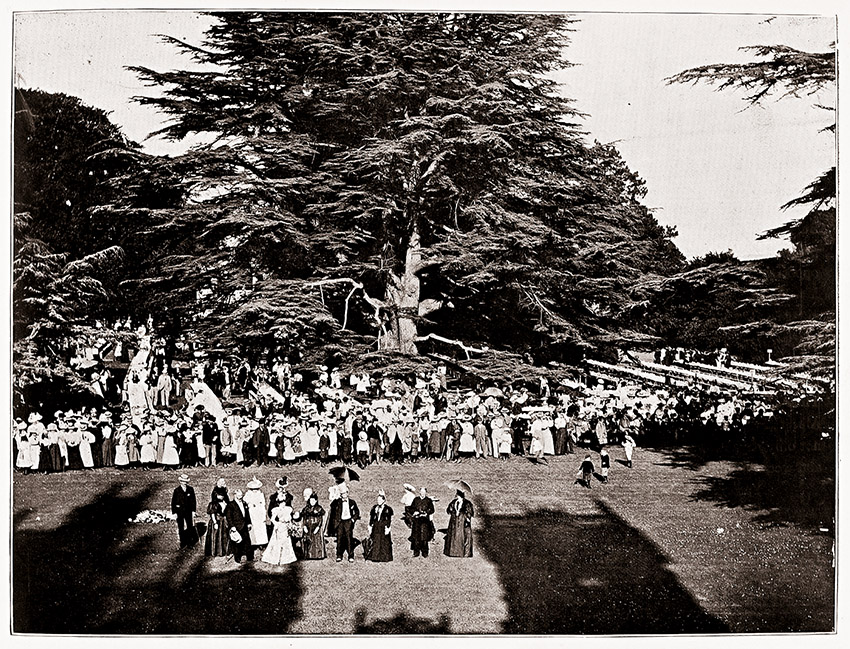
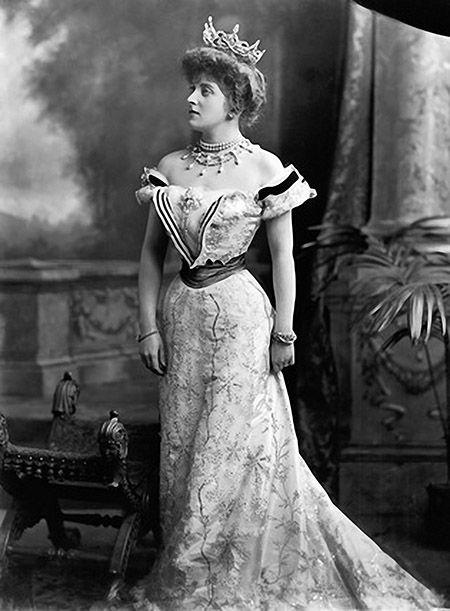 The question central to so many women’s lives is “what to wear”? Tinamay, a longstanding girlfriend of mine, explained to me that really it should never be a problem – we have been selecting our outfits and getting dressed since we were three or four years old and are well practiced. However, it never seems to me quite that straightforward. Costumes, fashion, what to wear and how to wear it are never out of the news these days. Image and presentation dominate every moment with instant contact through phones and the screens of people we have never met.
The question central to so many women’s lives is “what to wear”? Tinamay, a longstanding girlfriend of mine, explained to me that really it should never be a problem – we have been selecting our outfits and getting dressed since we were three or four years old and are well practiced. However, it never seems to me quite that straightforward. Costumes, fashion, what to wear and how to wear it are never out of the news these days. Image and presentation dominate every moment with instant contact through phones and the screens of people we have never met.
Perhaps one of the reasons it is hard to decide and easy to get wrong is that there are fewer rules to follow these days. In the era in which Downton Abbey was set, you either met the Dowager Lady Grantham in person or perhaps admired a portrait of her. Depending on the social occasion, her dress code was rigidly proscribed by the social mores of the time and even more so perhaps when sitting for a portrait.
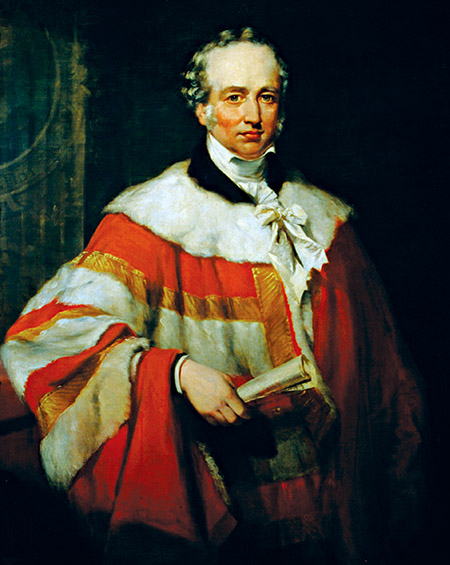
The 2nd Earl of Carnarvon
At Highclere you can see portraits of my husband’s earlier ancestors. Often they chose to be dressed in their parliamentary robes. These have changed little since the descriptions by the antiquary and barrister John Selden, published in 1614 in his helpful book ‘Titles of Honour’. Such robes are simply handed down through the generations and the portraits speak a rather different language to so many pictures today. Words such as respect, duty and honour. Apart from parliamentary robes, the aristocracy would also own carefully stored coronation robes. These are made of crimson silk velvet, extending to the feet, whilst the rank of the peer is indicated by rows of “ermine tails” on the miniver cape: 4 for a duke, 3½ for a marquess, 3 for an earl, 2½ for a viscount and 2 for a baron.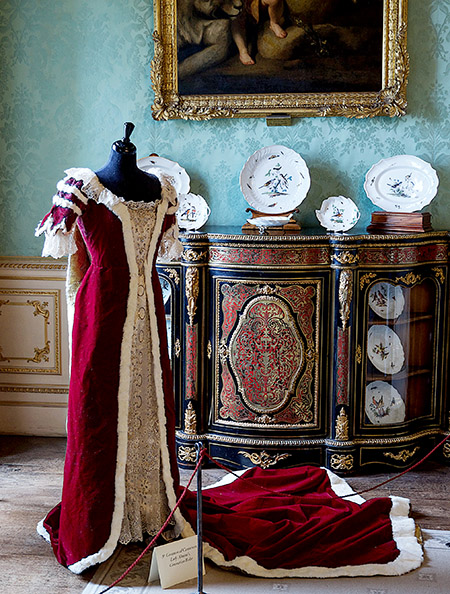
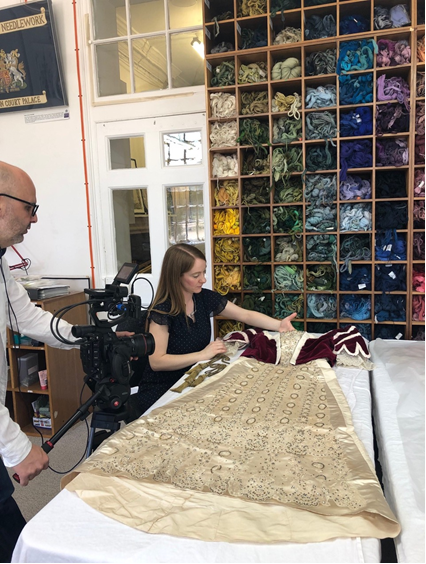
The Royal School of Needlework has a rich history in working on pieces for Coronations including the Coronation regalia for Edward VII, King George V and Her Majesty The Queen
We still have, here at Highclere, the coronation robe owned by the fifth countess, Almina, comprising a crimson velvet “kirtle” which is really a long train of matching crimson velvet, edged with miniver, over a full evening dress; Again the length of the train matters – a Countess had a 1½ yard train, no more and no less.
It is currently being restored by the Royal School of Needlework so that it can go on display later on in the year at our Costumes and Cocktails weekend in September where it will form part of a small exhibition of “Highclere” clothes from that era. I hope it might give enjoyment as it is always so interesting to see the quality of beading and fabrics in vintage clothes even if, after 100 years, they are not quite so pristine as they once were.
The 5th Earl and Countess attended both the coronation of King Edward VII on August 9th 1902 and that of King George V on June 22nd 1911. To many fans’ delight, the Downton Abbey film trailer has been released and depicts a visit from the King and Queen. The Dowager is suitably dry, everyone practices their curtsies and battle is apparently joined between the faithful Downton Abbey servants and those of the Royal Household.
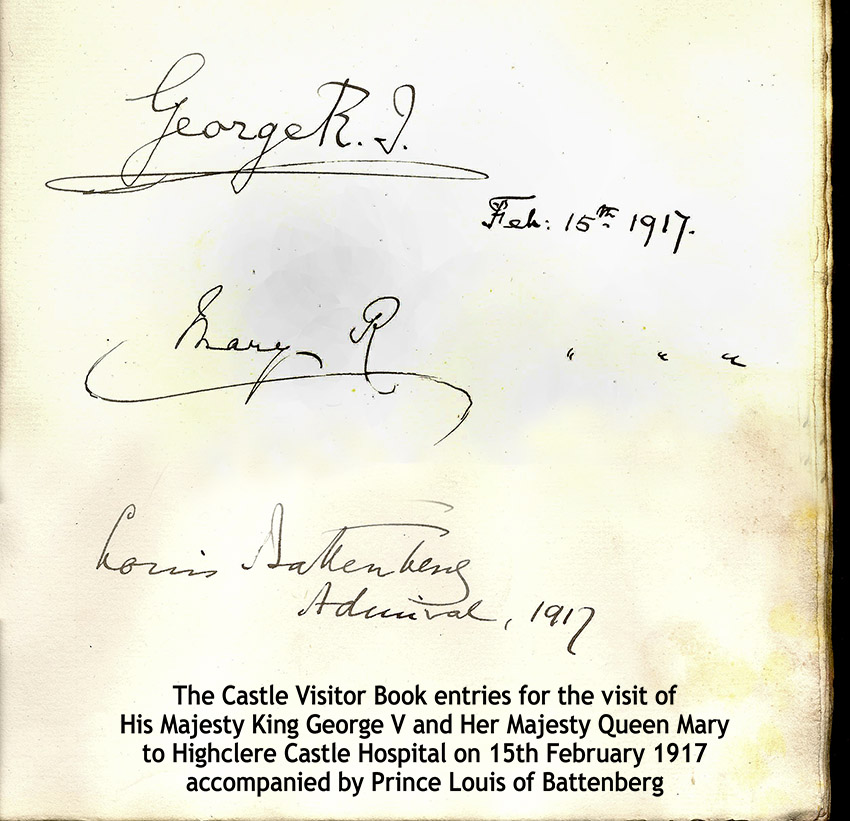 In reality, Highclere too has been most fortunate and welcomed royalty over the centuries. Queen Caroline’s bedroom is so named after the wife of King George II when she stayed here some 250 years ago and of course Edward VII came for a shooting party.
In reality, Highclere too has been most fortunate and welcomed royalty over the centuries. Queen Caroline’s bedroom is so named after the wife of King George II when she stayed here some 250 years ago and of course Edward VII came for a shooting party.
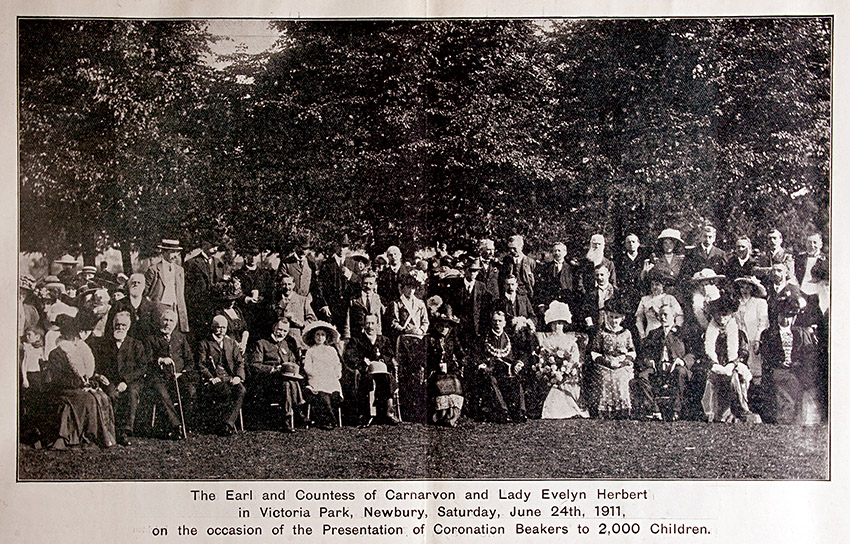
Rather more by luck than foresight, I combined the title of our September weekend of costumes with the word cocktails. It is most fortunate as, of course, we have just now produced and bottled our own gin. George V (whose signature is above as well as making an appearance in the Downton film) gave another gin brand a royal warrant in 1925 so I am happily presuming that he rather enjoyed the odd gin and tonic and that this is all a rather marvellous coming together of a theme.
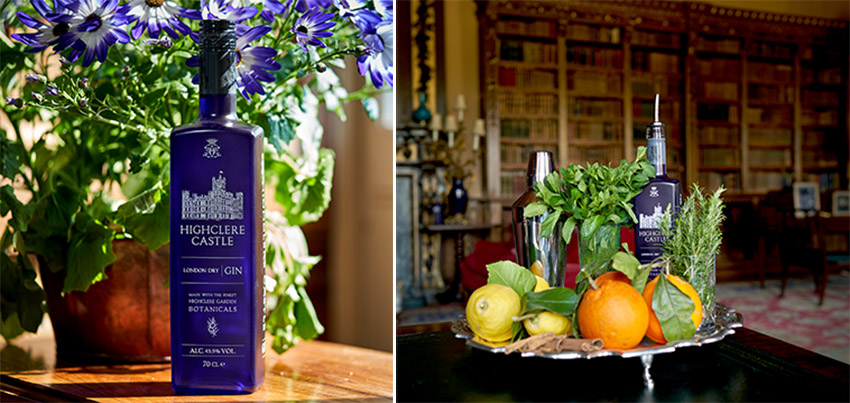








 Instagram
Instagram
Thank you for so graciously talking with my husband and me just a short while ago today! Enjoyed reading this post having just come from London and being steeped in royal history and artifacts. And of course we enjoyed touring your lovely home and Egyptian exhibits. Thank you.
Delighted to meet you!! A few lovely moments of sunshine too.
Thibodeaux! You’re Acadian? Or Cajun? So nice to see a familiar last name here.
Lisa Doucette
Delightful!
Wow! That’s an amazing bit of history! Thanks for sharing.
I look forward to Monday and your Blog Thank you
MY DEAR LADY CARNARVON,
THANK YOU FOR AN INTERESTING BLOG.I LOVE ENGLISH CASTLE AND YOUR HISTORY .
HIGHCLERE CASTLE IS BEAUTIFUL.
My family visited Highclere yesterday (Sunday, 26 May) and it was beautiful. We enjoyed our visit. All staff were very helpful and friendly. We ate lunch in the tearoom and the chicken and veggies were delightful! Thank you again for opening your home to us.
It was a wonderful memorable day
good morning! Thank you for another wonderful story from Highclere, and thank you for the wonderful conversation a few weeks ago in your garden. It was truly the highlight of my holiday!
Joan Lerch
St. Louis, Missouri
USA
How do you come up with a new and interesting topic each week — you are indeed a writer that actually transports me to England! I ❤️ the history of Highclere as it is a living history that continues daily.
What a privilege to read your blog that you share with all — you make every Monday morning special and thank you for the opportunity.
Thank you –
Dear Lady Carnarvon,
The topic of your newest post could not have been more special for me. All week I have been reading your book, Lady Almina and the Real Downtown Abbey… It is a grand and glorious story. There are so many favorite parts of the story; too many to mention them all. One delight was the weekend when the Prince of Wales came for the weekend. Young Lady Almina left no detail to chance and the weekend was a complete success. The story of the Great War was difficult to read, however, Lady Carnarvon stepped up by opening the doors of Highclere to make it a hospital for the wounded. I believe through this experience she found what gave her the greatest joy in life; helping others. Dear lady, you know what’s in the book so I won’t continue. To anyone who has not read it, please do!
Have a great week!
Mary Watkins
W.Memphis, Arkansas
Thank you- it was a book with a heart …
Thank you so much. A really interesting account. I loved the photos too.
Fascinating information on costumes and cocktails.
What a beautiful bottle you created for your gin.
Please fix Almina’s hem where it is tucked under.
Than you for yet another terrific blog.
Whitefish, MT. USA
The gown is away for 4 months being fixed! Thank you – it is a great bottle!
What is miniver ?
It is a type of white fur
Costumes and Cocktails! Fun! I’m amazed at how tiny Almina’s waist was!!
18″20″?
Always love reading your posts, especially those about Highclere history. I would love to visit and see the clothes exhibition and the coronation robe. How long will it be on display? Thank you for always sharing your amazing knowledge. Have a wonderful summer!
The coronation robe and gown look absolutely beautiful. I wish you great success for your up and coming Costumes and Cocktails event.
Oh, and the gin looks quite good as well!
Lovely post. Thank you.
Thank you
Lovely post again. I always ponder why it’s so hard for us women to find something to wear, even with a closet FULL of clothes!! It always either gives me grief or gratitude. Oh well….the woes of a woman. I admire all the costumes and clothing of our historical ancestors, some of them could NOT have been comfortable! (Corsets!)
I hope you’re having a lovely day.
I agree – and this morning I had nothing to wear..
Another welcome diversion from the standard Monday morning of news & phone calls re: projects. Thank you so very much for the updates and the attitude with which you embrace your contribution to Highclere. I am anticipating a trip to enjoy the treasures you have presented to us when I continue my genealogy studies in England.
Lady Carnarvon,
Thank you again for a lovely look at the distinguished history of Highclere Castle. I look forward each Monday morning on the other side of the pond. Living in North Carolina, I am amused to know the namesake for the Carolinas was one of the persons to enjoy the hospitality of your home many years ago!
Martha G.
Cary, North Carolina
Wonder what they ate?
From the books I’ve from that period and before, one would have to really like the food served even at stately meals!
It is just trying and eating a little – I sometimes think they had more diversity than today
Dear Lady Carnarvon,
Yet another wonderful blog, what a gorgeous coronation robe, I also like the beautiful display cabinet behind it, are you selling the gin in your shop? the bottle is wonderful, and I’m partial to the odd G&T or two!!
Regards
Lorraine.x
In the shop for sure – it has a listing at Harrods and we now need to implement the distribution
Hope the gin will be available in the States. Our Maryland weather is getting more and more gin-and-tonicy!
I hope it will be with you soon
Hi what beautiful pictures of haute couture! Ahhhhh such eye candy.
thanks the blue bottle reminds me of a young girls perfume in the 50s – Evening in Paris.
wonderful memories.
thank you happy summer.
slmost forgot – what are the children beakers
Another name for mugs really – they were gifts in honour of the Coronation of King George V
Dear Lady Carnarvon,
Thank you for your Monday Blogs. They are always enlightening and entertaining. The Highclere Gin bottle is exquisite. Did you take part in choosing the design? Is it sold in the US?
Sincerely yours,
Theresa F
It is going to be sold in the USA – we have made a production run for export
Dear Lady Carnarvon,
The gin is wonderful!! Looking forward to seeing the robes later in the year, I had only recently wondered if you had them still! I love looking at old costumes and I know yours will be beautiful!
G&T time, cheers x
I hope so we have some pretty dresses too – we are just working out how to display them and where to find some old fashioned mannequins
Lady Carnarvon, Once again you have captured my attention with more fascinating details connected to your home. I’ve just returned home from England and a most memorable visit to Highclere Castle back on May 7. A young Argentinian man who shared our taxi ride to and from Highclere Castle was absolutely overjoyed to tell us of his chance meeting with you in the gift shop. I must admit I was sad I missed seeing you too. It was wonderful to walk the paths all around the gardens. A perfect way to celebrate my 60th birthday. Thank you for sharing your home.
I am sorry I missed you..the walks and gardens are rather lovely
I really enjoyed your post full of such interesting history. After looking at the picture in Victoria Park in June, 1911 I am wondering what temperatures you have during that time of year. I am in South Carolina in the states and it is in the 90s. Although the clothing is beautiful it seems to me, that it will be horribly hot.
It can be about 18 degrees centigrade or maybe 22 ..
Just like in the opening line of Daphne Du Maurier’s novel, Rebecca, “Last night I dreamt I went to Manderley again” …I dream of visiting Highclere !!! The beautiful words you write about the history of the house, from the clothes of the fine ladies to the shooting weekend parties and photos. Keep blogging so I can keep dreaming, please. One day, I hope to get there.
Thank you.
Chris-Ann Dunn
Covington, Louisiana
In the meantime I keep writing – you will know so many nooks and corners by the time you get here!
Will Highclere Gin be available in Canada?
I commend you and your team on the marketing and PR you do on behalf of Highclere, and totally appreciate the huge scope of work that goes into keeping the Castle and its other buildings (including barns) up and running. I just bought my great-grandmother’s house in Nova Scotia back into the family. Built in 1857, Myers Keep and the barn that goes with it belonged to successive generations of our family until 1993, when it was sold. When the property came back on the market last fall, I jumped at the chance to get it back. I am now renovating and restoring the house, and generally figuring out how I can enjoy it, fund the restoration, and educate people on the history of the place. This summer, we’re starting on the barn. I take lessons from you on a regular basis. Cheers from Nova Scotia!
thank you – I know we have gone to see you Liquor board but we are in their hands!
Dear Lady Carnarvon,
What a wonderful article and photographs, too. I have always been fascinated with dress and costumes, ever since I was a child. I still have a one or two books that show pictures of both ancient and foreign dress, and I used to pour over our encyclopedia’s pages on that subject (my next favorite was the section devoted to dog breeds). It has been one of my delights to follow the changing of style on the television series and I highly anticipate the same in the forthcoming movie.
I am sure you will not be disappointed!
I am declaring that the first picture you posted is the best vintage photo I have yet to see from Highclere. It’s nice to see faces and detail, however, this staging couldn’t have been better. That magnificent tree is to be awarded a station of its own, then the shadow of the castle being cast down landing on a few but generally unobstructed informing all onlookers of where they are….the throng of people there not ever guessing that people from around the globe in the 21st Century would be gazing at their images and smiling.
Thank you it is amazing isn’t it?
Highclere gin!! I do hope it will be on sale in the gift shop over the September Costumes weekend?
Absolutely in bottles and in cocktails..
Thank you for sharing the history and symbolism of the robes and costumes of the Lord and Ladies of Highclere. How elegant ( and how tiny a waist) was the gown of Lady Almina. It was interesting to see that King George V and Queen Mary did in reality visit Highclere Castle, in 1917, and in the Downtown movie will visit in 1927! Come September, hoping that your Costumes and Cocktails event will be a great success ( and ‘love the blue bottle of Highclere gin, super!).
Thank you !
Dear Lady Carnarvon,
Gin is my favorite!!! (or is this really bad to admit). I loved this blog post and I am always a fan of fashion past and present. Especially when it is in the form of the jaw dropping costumery of Downton Abbey. I am so glad you addressed this fascinating topic as I am enamored of all of your stories. I just wanted to say Hi and say I hope you are having a lovely day. I also wanted to mention that I am EXTREMELY excited about Christmas at Highclere (your new book for your readers who do not know.) Please mention the release date to your loyal readers!!! Enjoy the Spring weather!!
Warm Regards,
Ann Catherine Flood
I will look forward to hearing the release date myself!
We will have some lovely costumes to share in September
Tuesday 28/5/19
Dear Lady Carnarvon,
What a great idea for a party! ‘ Costumes and Cocktails’. It is times like this I wish my grandparents didn’t emigrate to Australia. Especially when I hear of great fun for parties and interesting plays and cast being preformed in London. Thank God for ‘National Theatre Live’, I say. I guess we could have a costume and cocktail party for Halloween. Even though Halloween is an American custom, we Australians are starting to embrace this night of fun more so every year. It’s not quite here yet but every year our supermarkets ‘Coles and Woolworths’ (American owned) fill their shops with all things for this event. Your Gin bottles would not look out of place. Can’t wait to read your blog about this in September.
Getting back to the topic of Coronation robes, yours for the Coronation of Charles would be a mind field to administer as the papers today are brutal. I’m sure though, yours will be wonderful, as you have very good taste as I have seen in many articles about your family estate. And “ditto” from me to Ida DUPPLECHIN message as well.
Take care and all the best for the coming week.
Heather from the land down under.
The coronation robes are beautiful! How long is the Queens “ermine tailes” if the Marquess is 31/2 feet? Can you please tell a little more history about the castle? I think that it’s beautiful! I have always love learning about castles and their history!
I will have to measure the train …there is so much to relate – the past blogs hold quite a few stories!
Dear Lady Carnarvon,
I’m late reading again today! But this was such a wonderful entry! The very old photograph is a treasure…how wonderful to see it. It is like a fairy tale. The grandeur of that time is just fascinating. But my favorite photo is the Gown! I really appreciate the explanation about the length of the train and the number of ermine tails determining the status of the wearer. How fascinating! I would have never guessed it. I get a picture in my mind of Hyacinth Bucket going around counting the number of tails so she would know who to cozy up to to achieve her goal. Too funny!
Blessings,
Sue Smith
Englewood, Florida
Dear Lady,
I had my first gin and tonic a couple of months ago and loved it. Do you know where those of us in America may purchase your new Highclere Gin?
One other favorite from the Lady Almina book was the name Capability Brown. How unique!
Mary
W. Memphis, Arkansas
Like everyone in the USA, our partners were with their families on Memorial Day so I have some questions today and can then revert to you! It is a good drink.
Thank you.
Lady Carnarvon,
I will be joining your blog tomorrow. What is the name of your book that I might read it? My passion is European history. Hope I can access back issues of your blog.
Thank you,
Sandy Allen
Longmont, Colorado
You can read as mush as you would like – just dip in – European history is also our history, disputes, wars, treaties and all that we have in common from our language to our literature and music.
Dear Lady Carnarvon
Thank you for providing information and exquisite photos. Best wishes for the display in September. Kindest regards.
Thank you – it is just time out in a world apart – time to enjoy childish things such as carousels – learn to dance, listen to a band, forget about schedules …
It was lovely to run in to you yesterday, an unexpected pleasure to renew an aquaintance through our dear departed fathers. We enjoyed the country fair too. Best wishes, Alexandra Cresswell (Lane)
Very nice to see you too – so lucky I decided to stop and get a cup of tea!! It is funny how momentary decisions and then saying hello makes all the difference
Kathy Thibodeaux, thanks so much for the post.Really thank you! Keep writing.
Your own gin? One more point in my favor in getting my husband to come with me to Highclere! And I need every last one I can get, he is not a traveller, but he does like a gin and tonic.
Thank you again for your lovely post, and sharing of the history of Highclere. There is so much more to learn than just being a point of interest from Downton Abbey.
Thank you – it is really delicious!!!
We are finally winging our way to England and are so excited to be in your area on a day when we can take a tour and have tea.
i have been dreaming of this since 2011.good things come to those who wait.
When are you coming here?
June 5 10:30
What is the most efficient public transportation
From newbury? How long does it take?
Are we allowed to walk around the grounds
After the tour and tea? Can’t wait!
Taxis wait at Newbury railway station so that is not a problem -it is maybe 15 minutes? Do go for walk afterwards!
Do you have a shop where we can perchase the bottles of your gin as gifts.l do hope so.when l visited Highcllere l remember the tea rooms but not a shop.Thank you.
Yes, there is a gift shop in the courtyard – opposite the tea rooms.
MY DEAR LADY CARNARVON,
Who is The Lady on the first picture. Look like Princess Daisy von Pless, is it she?
Best regards,
Przemysław J.
That is Lady Almina, the 5th Countess of Carnarvon.
Thank you for the answer.
Dear Lady Carnarvon,
At the outset of this post, I apologise for its length. However, I have deferred it’s posting on the Blog until now so as to not disrupt or impose upon the postings of fellow bloggers.
I thought that I might just add to the conversation a brief history of the robe as part of a a barrister’s “dress”. (I also credit a 2014 article by Mr T Bradley QC for much of what follows.)
My understanding is that originally barristers’ robes could be quite colourful. Even judges wore coloured robes, green being the most favoured until the middle of the 15th century, when scarlet came into vogue.
From the time of the Reformation, robes generally became darker and less extravagant. In 1577 the Inns regulations prohibited “frivolous items of clothing”.
The Judges of King’s Bench drew up dress rules in 1635, which formalised these arrangements. Black or violet robes were to be worn with similar coloured hoods.
By the early 17th Century a distinctive Bar gown had become customary for Barristers. It was made of black cloth or grogram, with velvet facings and two vertical strips of velvet on the upper sleaves. The 1635 rules of the Inns prescribed, “Dress on all occasions is to be in gowns of a sad colour”.
Under the rule of Oliver Cromwell and briefly his son Richard, everyone, including the judiciary abjured any distinctive form of dress.. Upon the Restoration, like much else, traditional robes were quickly re-introduced.
The ‘Noble Robe’ of counsel returned, with velvet on the back, and adorned with tufts and lace.
When I was called to the Bar, the reader’s syllabus taught that the wearing of today’s black robe by all arose when the Bar went into mourning at the death of Queen Anne and that it has remained so ever since.
However in more recent times, legal scholars have suggested that it was not Queen Anne, but rather Charles II, who was the most influential person in the history of legal dress. It is said that the evidence points to it being his death in 1685, when the black ‘court suit and mourning gown’ was adopted by Counsel. That would make the observation concerning Queen Anne to be out by almost 30 years.
In support of the ‘new’ theory, it is noted that contemporary depictions show the simple black gown was worn by counsel for the funeral of Queen Mary twenty years before in 1694.28 And in 1697, Chief Justice Holt of King’s Bench complained of having to hear barristers in mourning gowns.
Thereafter, the black robes became the norm for barristers and little has changed from the time of the late King’s death. Not everyone welcomed the simplicity and drabness of the black gown. Sir Henry Chauncy, writing in the 17th century, complained:
“It seems very ominous that these learned Men should now decline this Noble Robe and wear a scandalous Livery which resembles those that Bearers usually wear at Funerals, as though the Law lay a dying…and divesting it of that ancient robe, and introducing an ignominious Habit in the room of it.”
The 17th Century also saw the establishment of the rank of Queen’s and King’s Counsel, who wore black robes made of silk to distinguish them from junior counsel.
I will leave the history of the legal wig for another day.
Yours faithfully,
Jeffery Sewell
Thank you !
Lady Carnarvon, you have done a great job adding modern touches to Highclere whilst preserving and respecting its heritage. You are the perfect lady for this magnificent house.
The red robe is lovely and the velvet is still such a vibrant color! Your affair in September will be a success – I am sure of that!
Dear lady Carnarvon,
The coronation robe is just beautiful. How wonderful that you still have such treasures! I wish I could be there in September for Costumes and Cocktails. It sounds like such fun!
Dear lady Carnarvon, would you a your husband ever consider a role in Downton Abby?